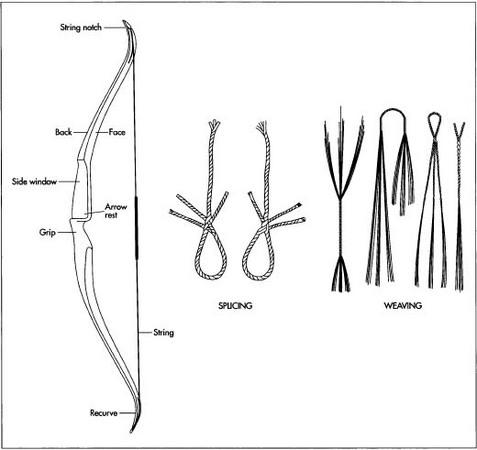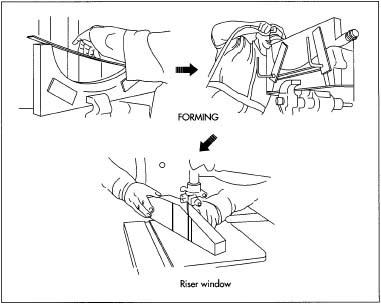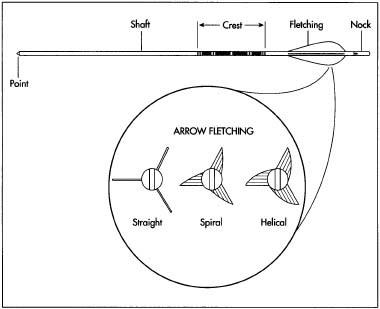Bow and Arrow
In simplest terms, a bow is a long, flexible staff; a shorter string is attached to the staff's two ends, causing the staff to bend. An arrow is a shaft with feather-type vanes near one end, which is notched, and a pointed head on the other end. The notched end of the arrow is mounted against the bowstring, with the pointed head extending just beyond the bow. With one hand braced against the bow and the other gripping the string, an archer pulls back on the string, storing potential energy in the bow. When the archer releases the string, that potential energy is converted to kinetic energy, which is imparted to the arrow, propelling it forward suddenly and swiftly. Bows are used primarily for hunting and for target shooting.
Background
Archaeologists believe hunters used bows and arrows as early as 50,000 years ago. Indigenous people used such weapons in every part of the world except Australia. In addition to hunting and warfare, bows and arrows were used for sport in ancient cultures of Egypt, China, and India.
Originally, bows were made of any springy material, including bamboo as well as various types of wood, and the bowstrings were made of animal gut. Native American and Asian bow makers independently made an important innovation when they reinforced the weapon by gluing animal sinew (tendon) to the back of the bow (the side facing the target). The composite bow (one made of three or more layers of dissimilar substances) was invented by several cultures in Central, North, and Southwest Asia as much as 4,500 years ago. The technique included reinforcing the bow's back with up to three layers of shredded sinew mixed with glue, and strengthening the face of the bow (the side facing the archer) with a glued-on layer of animal horn. Northern Europeans used a different method to strengthen bows; by the beginning of the fourth century A.D. , they were bonding a back of sapwood to a face of heartwood (dense wood taken from the non-living core of a tree).
Arrows, which were normally made of wood shafts, were tipped with arrowheads shaped from hardwood, bone, horn, flint, bronze, or (eventually) steel. In India, weapon makers experimented widely with iron and steel, and they produced an all-metal arrow during the third century B.C. Although it is likely that they made metal bows at that time as well, it was not until the seventeenth century that steel bows truly became popular in India.
Archery (using a bow to shoot arrows) was a dominant means of warfare (with standard bows proving to be generally superior to mechanically assisted crossbows) until the late sixteenth century, when firearms became practical. Since then, hunting and target shooting have developed as the main activities in archery.
From 1929-1946, seven archers who were also scientists or engineers studied the performance of equipment designs and materials using techniques like high-speed photography. They published their findings in various journals, and in 1947, three of them edited a collection of these articles, calling the book Archery: The Technical Side. These experimental and mathematical analyses of bow dynamics laid the ground-work for the first significant improvements in archery equipment design since the Middle Ages. Among the innovations that appeared after World War II were the use of new materials like plastics and fiberglass, and modification of the bow's grip section to resemble a pistol handle.
Design
The most basic type of bow, called a long-bow, is formed from an essentially straight shaft. Additional power and stability are achieved by recurved bows, which have permanent curves that make the bow's back concave at each end. Even more power can be achieved with a compound bow, a mechanically assisted device that attaches the bowstring to a system of pulleys rather than to the tips of the bow.
A recurved bow consists of three parts—two flexible limbs extending from opposite ends of a rigid riser. The bow's total length may be 50-70 in (125-175 cm). The riser, which is about 20 in (50 cm) long, provides a comfortable handgrip and a ledge on which the arrow rests prior to release. The limbs may be permanently attached to the riser, or they may be removable, allowing the archer to take the bow apart for ease of transportation and storage or to interchange limbs with different operating characteristics.
Raw Materials
When made of a single piece of wood, a bow can warp from moisture or become brittle in cold weather. It can also permanently deform into the curved shape attained when the bow is strung (the bowstring is attached to both ends, bending the bow). When this happens, the bow's springiness is decreased and it loses power. Making bows from fiberglass solves some of these problems, but with reduced performance characteristics. The best results are obtained with composite materials that are formed by gluing together layers of various woods, fiberglass, or carbon fiber. Among the woods commonly used for bows are red elm, maple, cedar, bamboo, and exotic woods such as bubinga.
Historically, bowstrings have been made from sinew, twisted rawhide, gut, hemp, flax, or silk. Today, strings for wooden longbows are often made of linen thread. Compound bows may be strung with steel wire. Bowstrings for popular recurved bows are usually made of Dacron, which stretches very little and wears well. Nylon thread is wrapped around the bowstring to reinforce it at the ends and in the middle where the arrow and the archer's fingers contact the string during shooting.
Arrows have traditionally been made of solid shafts of wood such as ash, elm, willow, oak, cedar, or Sitka spruce. Hollow arrow shafts may be formed of modern materials like aluminum, fiberglass, graphite, or carbon fiber. Feathers (commonly from turkey wings) mounted on the shaft near one end cause the arrow to spin during flight, steadying its path. Because of better durability and moisture resistance, vanes made of plastic or molded rubber have become more popular than natural feathers for this purpose. A nock (a plastic piece that is grooved to fit around the bowstring) is attached to the back end of the arrow. Arrowheads, which were historically made of flint, bone, horn, bronze, or hardwood, are now commonly made of steel. They may have two to six protruding blades, or they may simply bring the shaft to a rounded or pointed end.
The Manufacturing
Process
The bow
The following paragraphs describe the construction of a recurved bow with permanently attached limbs.
- 1 Various materials are cut into rectangles for the layers of the limbs. Wood layers are dyed the desired color. Glue is applied, and the layers are stacked in the proper sequence.
- 2 The multi-layer limb section is mounted on a form that will determine its final curvature. While attached to the form, the limb is cured in an oven at 180° F (80° C) for six hours.
-
3 The riser is made from a solid block of aluminum or a block formed by
laminating various layers of wood. After cutting the block down to a
basic outline of its final shape, pins are inserted near the
riser's ends to allow attachment of the limbs.
 A typical bow. In order to form a bowstring loop, the string can either be spliced or woven.
A typical bow. In order to form a bowstring loop, the string can either be spliced or woven. - 4 Holes are drilled in the limbs to match the position of the pins in the riser, and the limbs are temporarily attached to the riser. After the joints are sanded smooth, the limbs are removed from the riser.
- 5 Using a template, the bowyer (bow maker) marks the limbs for cutting. Using a power saw and a sander, the craftsman tapers and shapes the ends of the limbs from their originally rectangular shape. The ends of the limbs are filed to make grooves where the bowstring can be mounted.
- 6 The bowyer begins to shape the riser by cutting out sections to form a shelf on which the arrow can rest and to provide a sighting window. Using a power saw, a sander, and a hand rasp (wood file), the bowyer contours the riser into a shape that will be comfortable to grip.
-
7 The limbs are attached to the finished riser and glued into place.
Final shaping is done on the limb tips. The entire bow is sanded by hand
and then finished with a protective coating of clear epoxy.
 During bow manufacture, the limb is mounted on a form that will determine its final curvature. While attached to the form, the limb is cured at a high temperature and the riser is then attached to the bow with pins.
During bow manufacture, the limb is mounted on a form that will determine its final curvature. While attached to the form, the limb is cured at a high temperature and the riser is then attached to the bow with pins.
The bowstring
Although manufactured bowstrings are available, some archery enthusiasts prefer to make their own.
- 8 The number of strands of thread needed is determined. This depends on the strength of the thread being used and the draw weight (strength) of the bow. The bundle of strands is divided into three equal sets, and each set is coated with beeswax (perhaps with added resin). The sets of strands are then formed into a cord by twisting and weaving them together.
- 9 When enough cord has been formed, a loop is formed by bringing the cord's end around and splicing or weaving it into the new section that is being corded. When the bowstring's desired length is nearly achieved, the string is pre-stretched by hanging it from the initial loop while attaching a weight to the free end. The length is then reevaluated, and cording continues until the desired length is attained. Forming another loop finishes off the string.
- 10 "Serving" is applied by wrapping nylon thread around a 10-in (25-cm) section in the center of the bowstring and a 5-in (13-cm) section near each end loop. A reinforcement called a nocking point, which is made of rubber or plastic, is attached at the point where arrows will be mounted against the string.
The arrow
The following steps describe how wooden arrows are made.
- 11 A "two by four" (2 in [5 cm] thick and 4 in [10 cm] wide) of appropriate wood is selected, making sure the grain of the wood runs as close as possible to the length of the board. A section is cut that is about 3 in (7.5 cm) longer than the planned arrow length. Using a heavy knife or an axe, the board is split down one side to form an edge that truly runs along the grain of the wood.
-
12 Following the split edge, square blanks are sawed that are slightly
larger than the desired shaft diameter. If necessary, the blanks can be
straightened by heating them and bending them.
 The arrow is typically made of wood and coated with polyurethane and paint. Trimmed feathers or plastic vanes are glued to the shaft between the cresting and the nock in a pattern that is parallel to the shaft, spiral (in a straight-line diagonal to the shaft), or helical (in a curve that begins and ends parallel to the shaft). An arrowhead is mounted on the shaft. The shape of the head is determined by the purpose for which the arrow will be used—target shooting or hunting specific types of animals.
The arrow is typically made of wood and coated with polyurethane and paint. Trimmed feathers or plastic vanes are glued to the shaft between the cresting and the nock in a pattern that is parallel to the shaft, spiral (in a straight-line diagonal to the shaft), or helical (in a curve that begins and ends parallel to the shaft). An arrowhead is mounted on the shaft. The shape of the head is determined by the purpose for which the arrow will be used—target shooting or hunting specific types of animals. - 13 Each side of the blank is planed to ensure its smoothness and straightness. Then the four corners are planed off to form an octagonal rod. Again, the corners are planed off. Finally, the shaft is sanded to form a round dowel.
- 14 A nock, or slot, is cut into one end of the arrow shaft. Alternatively, the end of the shaft can be inserted into a plastic nock.
- 15 The shaft is coated with polyurethane or varnish. Cresting (bands of color that identify the arrow's owner or manufacturer) is applied around the shaft.
- 16 The arrow is fletched by gluing trimmed feathers or plastic vanes to the shaft between the cresting and the nock. These real or artificial feathers may be applied parallel to the shaft, spirally (in a straight-line diagonal to the shaft), or helically (in a curve that begins and ends parallel to the shaft). Usually three feathers are applied, one of which will face directly away from the bow when the arrow is mounted for shooting. This is called the cock feather, and the other two are called shaft feathers.
- 17 An arrowhead is mounted on the shaft. The shape of the head is determined by the purpose for which the arrow will be used—target shooting or hunting specific types of animals.
The Future
Building on the analytical approach begun in the 1930s, modern researchers are refining mathematical models that describe the performance of bows, in order to evaluate possible design changes. In addition to varying the size and shape of bow components, bowyers also experiment with new materials. For example, at least one manufacturer now offers limbs made with a core layer of syntactic foam (a high-strength, low-density material, composed of epoxy resin and microscopic glass beads that can be cast and machined).
Some archers use attachments on their bows to improve their performance, and manufacturers are developing increasingly sophisticated models of such accessories. For example, an electronic sighting device is now available that not only helps archers fix their aim on a target, but also acts as a digital-display rangefinder. New designs are also being developed for stabilizers that are mounted on rods extending outward from the back of the bow. These stabilizers consist of weights or hydraulic damping devices (movable weights encased in a fluid-filled cylinder) that help prevent twisting of the bow during shooting by absorbing some of the shock when the bowstring is released.
Where to Learn More
Books
Paterson, W. F. Encyclopaedia of Archery. New York: St. Martin's Press, 1984.
Williams, John C. with Glenn Helgel. Archery for Beginners. Chicago: Contemporary Books Inc., 1985.
Other
McNeur, Rob. Arrow Making FAQ. http://snt.student.utwente.nl/~sagi/artikel/faq/arr-w-make.shtml#question (December 7,1998).
"Steps in Handcrafting Our Traditional Bows." Harrelson Traditional Archery Inc. http://www.mindspring.com/~bowyer/ (October 25, 1998).
— Loretta Hall
Comment about this article, ask questions, or add new information about this topic: